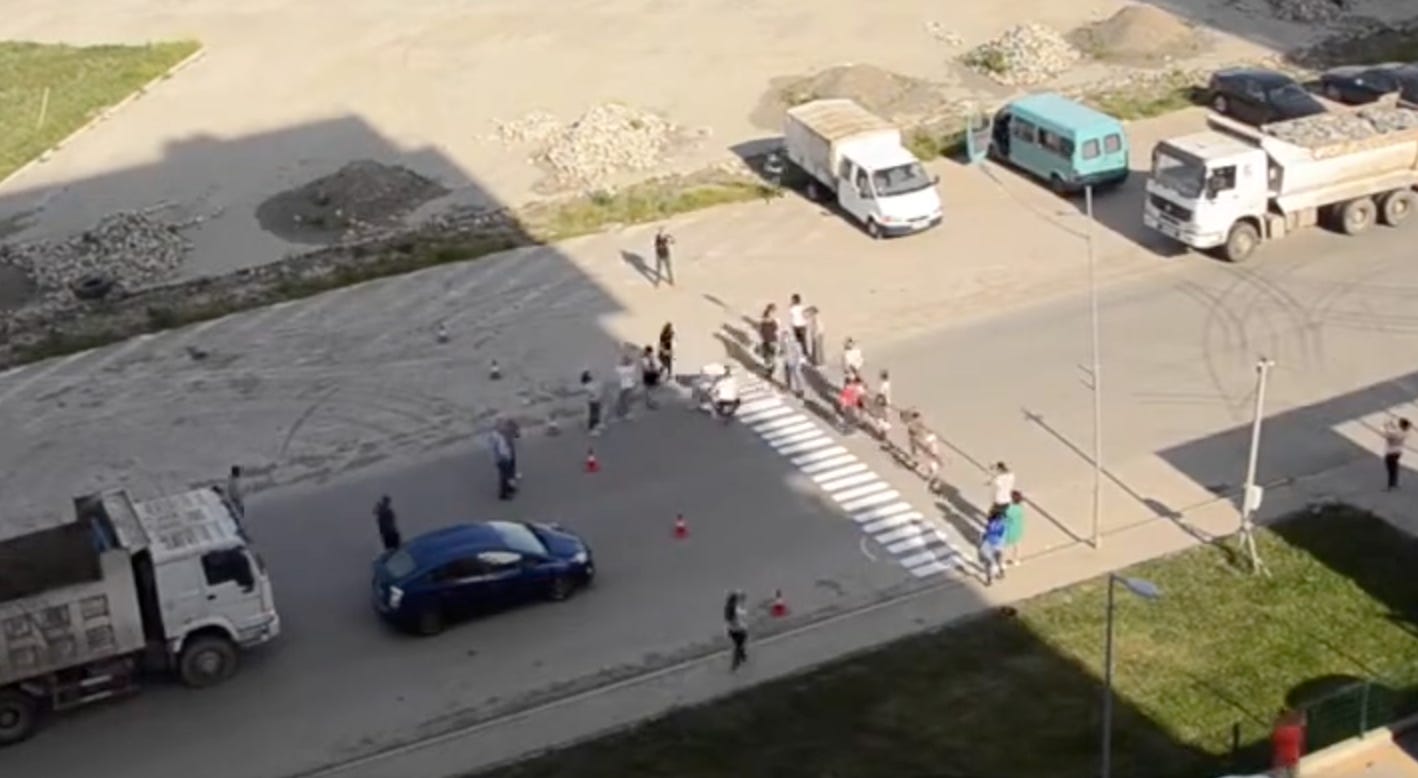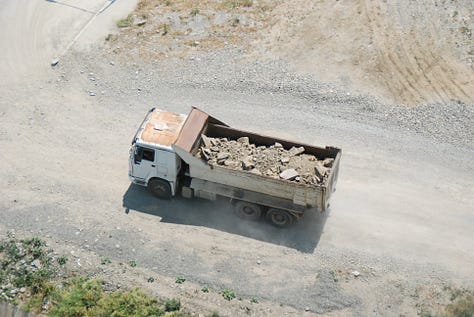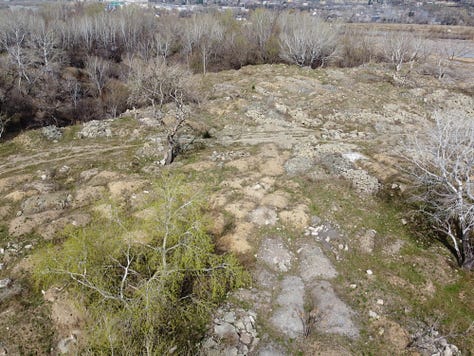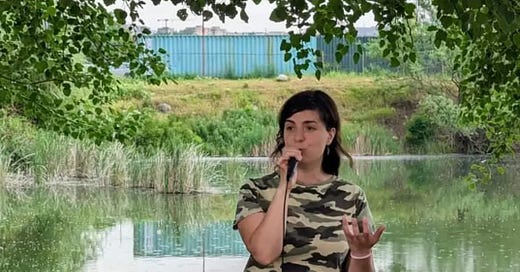From Academia to Activism at the Dighomi Meadows
A conversation with Ana Trapaidze, the founder of the Dighomi Meadows Neighborhood Initiative.
We are sharing stories of environmental optimism, perseverance, community-building, and experimentation in Georgia and the region. This month, Ruderal intern Philippa Gercke interviewed Ana Trapaidze, who is working to protect the Dighomi Meadows floodplain area of the Mtkvari River in Tbilisi.
Ana Trapaidze is a force to be reckoned with. A physics and biophysics lecturer at the State Medical University and mother of two, Trapaidze in 2020 launched a movement to protect an illegally exploited forest in the suburbs of Georgia’s capital, Tbilisi. In the years since, she has grappled with the government and prospective developers, built a deep-rooted community movement, and is now overseeing the implementation of a major environmental regeneration project involving multinational development banks and the Georgian government.
Throughout her shift from independent activist to community leader, Trapaidze has remained outspoken and determined to fight for the causes she considers important. Following the Georgian government’s reintroduction of controversial laws in spring 2024, Trapaidze was visible at the frequent protests, encouraging others and sharing information about the legal amendments and the fight against them, alongside her nature conservation work.
In March of this year, I met with Trapaidze to discuss her journey from academic to activist.
As the founder of the Dighomi Meadows Neighborhood Initiative, could you explain what the Dighomi Meadows are, and why they’re so important?
Dighomi Meadows is a riparian floodplain forest on the right bank of the Mtkvari river, the main river which flows through the city of Tbilisi.The Dighomi Meadows are located at the northern entrance to the city: a pathway not only for the river but also for air flow. I usually say that they’re the lungs and kidneys of the city.
It's a very biodiverse location and the last remaining riparian forest [in the city]. Riparian forests are vulnerable worldwide, and that's also the case in our city, but there’s now a trend of restoring these kinds of areas because they have huge potential in terms of both biodiversity and providing some resilience towards climate change. So I think it's a multifaceted beneficial treasure of the city.
You founded the Dighomi Meadows neighborhood initiative back in 2020. Could you share how it began, and what drove you to start with this initiative?
My family and I moved to the area during the pandemic. Before we moved, we thought this area was green and nice, because we saw on maps that there was a forest and a river nearby. But what we saw in reality was ongoing degradation: there was very intensive extraction of gravel from the riverbanks, and construction waste was dumped into the mine holes and the adjacent forest. In the first few weeks after we moved there, the landscape degraded so much.



That's when we started to ask around and I decided I was going try to figure out what's going on: if this was an official infrastructure project or if this was illegal. So basically, we turned into activists overnight. We asked the media to support us, and they came and gave us the label of ‘eco activists’.
You often share information about waste dumping on the site. What action is being taken to address it? And have you collaborated with the community, or has it primarily been you and your husband?
So first of all, my community is a very young community. It's a newly built apartment complex: not many neighbors know each other, and we didn't have a sense of community during the pandemic. However, we became unified because it was unbearable to see so many trucks coming to the site; our neighbors were really angry about the dirt and noise and dust of the trucks that arrived daily at high speed.
One of our first protest actions was drawing a zebra crossing. We couldn't even protest because we were so scared, but we stopped the traffic for 10 minutes. We could see what the vehicles were transporting in different directions — bringing construction waste in from one side and taking gravel out on the other side — and we could also calculate their number.

That was a time when the neighbors came together — we all came out. While we were out there we were sharing Facebook Lives all the time, because that was the weapon we had in our hands.
So you use the the internet and live broadcasting both for safety and to amplify pressure?
Yes, for security, it was something very instinctive. I was staying at home taking care of my kids and working from home. I saw trucks coming, and one more truck means 20 more tons of construction waste. I went down with my toddler in my arms, and asked myself: what do I do? how can we get help?
I turned on Facebook Live and said ‘you're being recorded now’. I felt secure, and some people also responded and came. This was our way of organizing people, by showing them what was going on.
Through your resistance, you challenge profit-oriented models of development. In doing so you confront powerful players like the government or corporations. What has their reaction been towards you?
What was going on was obscure. Why were they not taking measures that they were supposed to take? Many times the only response we got was that we needed to contact someone else. So we had to deal with both the wrongdoing itself and the authorities. We want to highlight both the criminal acts, and the weakness of the institutions that should be preventing them.
You started the fight while working from home because it was the pandemic, as a mother of two kids and as a neighbor. What kind of challenges have you faced?
From my window I had a good view of the site. I was lucky that I was working from home, and as a lecturer I had flexibility, so I could shift my duties so I could accommodate activism.
The first days were a sprint: we had to write emails to inform people, gather people, contact everyone, mobilize all the resources, and communicate what's going on. I would forget to feed my kids. I remember clearly that for several months we often only had time to order something. When people asked me how they could support us, I said maybe send some pizza. That was a big sacrifice I had to make, neglecting my own family all the time.
Why do you think it's important for us to speak about female activism?
I have most experience in Georgia, and what I see is that activists are usually women. I don't know why, but maybe it’s do with the job market — Georgian women often agree to a job first, and only later look at the financial aspect of it. It’s the same for me with activism: the purpose is more important than the money. Maybe I have to compromise and won’t be focused on my career, but I’ll pursue this activism.
Many women do that. I think it’s because we already experience so much inequality, and so are ready to take on a variety of different roles. I think this versatile approach makes activism more feminist.
And what gives you the hope or strength to carry on with the work you’re doing? What inspires you?
When I first started people would tell me that court cases can last years, and it will be a long and hard path. But I want justice, for me justice is very important.
There are going to be some sprints, but a lot of it is a marathon where you have to spread your energy evenly, and maybe sometimes get a boost. Usually the boosts are when I see new activist groups forming, and they tell me ‘We heard your interview and got inspired that we could protect our local playground or lake, and also bring change to our community’. That gives me so much energy. Being part of the formation of an environmental activist network is the most rewarding. It’s a big honor and joy.
What changes have occurred since you started, both for you personally and for the meadows?
I’ve been doing this for four years already. I often say that in four years someone can get a PhD degree.
If there was a PhD in floodplain activism, you would definitely have got it!
I have ended up becoming a professional in this. I’ve sacrificed many things, but gained so much experience and so many skills.There’s a feeling of ‘flow’ when something works out and you succeed. Personally, it’s been a really fantastic experience.
And in terms of the meadows, we’ve managed to stop the criminal activity that was ongoing: we stopped the trucks and even the gravel mining factory: their site got demolished after a three and half year fight. We’ve got attention from people and the media, and gathered supporters in the city and country-wide. We’ve managed to get City Hall to get professionals together around a table.



Now there’s ongoing development of the Dighomi Meadows rehabilitation strategy. This document involves first of all setting a baseline to understanding what we have right now. Some investigation helps us to map out the condition that the meadows were in a few years before the destruction, and what steps are needed to restore the place and make it beneficial for our society.
So this project is ongoing, including public discussions on the proposals, in which non-governmental organizations and civil society play a major role. When the document is released we will have to make sure that the action plan is being followed.
To end this interview: what is your vision for the future of the Dighomi Meadows?
I really want the Dighomi Meadows as much as possible to turn into a real floodplain forest with a riparian forest. We have a new law on forests in Georgia, and if the area is categorized as a floodplain forest it becomes a specially protected forest. The law has many different instruments to protect the forest. I the floodplain to be rehabilitated, and for the majority of the area to turn into riparian forest.
Ana, thanks so much for sharing your words, wisdom, and experience. We wish you all the best for the fight.
Let us know about projects or people making a difference in the local environment by sending us a direct message via our Instagram account.
Photography: Ejvind Spence, Dighomi Meadows neighborhood initiative
Edit: Anna Edgar







